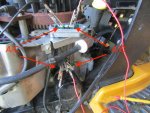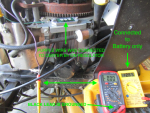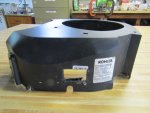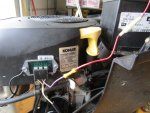Adsila Sinewa
Member
- Joined
- May 1, 2019
- Threads
- 3
- Messages
- 10
I recently purchased a new regulator/rectifier for my 23 hp Kohler engine (12/15A part# 25 403 35-S)
Before installing the regulator/rectifier and replacing the Blower Housing, I decided to first test the voltage regulator to make certain that it was going to output the required 12+ volts. I did this by the following test.
1. I hooked up my multimeter to the rectifier-regulator plug A/C terminals and ran the engine at 3600 RPM which displayed 43 volts AC. (I've read that I should have at least 28 volts AC. Could the regulator be putting out too much A/C?)
2. I then attached the rectifier-regulator to the engine making certain that it was well grounded. See attached photo.
3. I then connected a red wire from one (out-) side of the rectifier-regulator plug to one side of the A/C terminal of the rectifier-regulator. See attached photo.
4. I then connected a black wire from the other (out-) side of the rectifier-regulator plug to the other outside A/C terminal.
5. Next, I switched my multimeter to DC and placed the red lead to the middle B+ terminal and touched the black lead to the engine (in several spots). However, I only got a reading of .02 Volts DC.
Could you tell me what I’m doing wrong in my test? The regulator/rectifier was a new original Kohler item.
I went ahead and attempted to fully install the regulator/rectifier, but the battery did not indicate that it was charging.
In placing the order I used the information derived from kohlerenginesparts.com. See the attached screenshot:
I purchased this engine new in late 2016, but I discovered late last fall that the voltage regulator tested defective. Although I have a new high quality battery and the engine starts without a problem, obviously I need a working voltage regulator.
Any assistance you can give me will be greatly appreciated.
Before installing the regulator/rectifier and replacing the Blower Housing, I decided to first test the voltage regulator to make certain that it was going to output the required 12+ volts. I did this by the following test.
1. I hooked up my multimeter to the rectifier-regulator plug A/C terminals and ran the engine at 3600 RPM which displayed 43 volts AC. (I've read that I should have at least 28 volts AC. Could the regulator be putting out too much A/C?)
2. I then attached the rectifier-regulator to the engine making certain that it was well grounded. See attached photo.
3. I then connected a red wire from one (out-) side of the rectifier-regulator plug to one side of the A/C terminal of the rectifier-regulator. See attached photo.
4. I then connected a black wire from the other (out-) side of the rectifier-regulator plug to the other outside A/C terminal.
5. Next, I switched my multimeter to DC and placed the red lead to the middle B+ terminal and touched the black lead to the engine (in several spots). However, I only got a reading of .02 Volts DC.
Could you tell me what I’m doing wrong in my test? The regulator/rectifier was a new original Kohler item.
I went ahead and attempted to fully install the regulator/rectifier, but the battery did not indicate that it was charging.
In placing the order I used the information derived from kohlerenginesparts.com. See the attached screenshot:
I purchased this engine new in late 2016, but I discovered late last fall that the voltage regulator tested defective. Although I have a new high quality battery and the engine starts without a problem, obviously I need a working voltage regulator.
Any assistance you can give me will be greatly appreciated.







